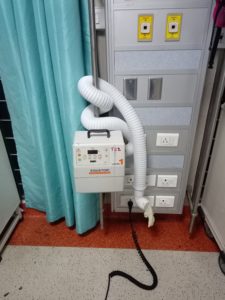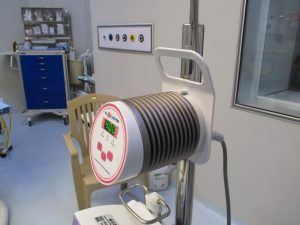Thermoregulation in newborn to maintain the temperature. To prevent Hypothermia in the newborn, infants and in a pediatric patient.
Radiant warmer for the newborns
Bair Hugger Device Patient warmer with warmer blankets
Warmer Thermo warm
Haemo therm for iv fluids rolling types
Cassettes types for iv fluids
Fluid warming device
Incubator
Infant Radiant Warmer with Fixed Baby Cradle & Drawers.
The mobile Warmer mounted on wheels with fixed baby cradle, lower shelf, and 3 drawers storage Cabinet.
Technical Specification
Heater Box
Consists of Ceramic Infra-Red Heater 650 Watts
The source box can swivel to take an X-ray. Due to temp. The insulated cover on the heater box, its exterior surface remains cool even after the long run.
Due to temp. The insulated cover on the heater box, its exterior surface remains cool even after the long run.
The construction of the stainless steel reflector and Guardrail is such that the complete cleaning of heater & reflector is possible without any electrical shock hazards.
Infant Radiant Warmer with Fixed Baby Cradle & Drawers (Standard)
The mobile Warmer mounted on wheels with fixed baby cradle, lower shelf, and 3 drawers storage Cabinet.
SCD Skill 1-1
Maternity Nursing Skill 1
THERMOREGULATION USING A RADIANT WARMER
If thermoregulation is not adequately maintained, the newborn may suffer from cold stress, which can affect oxygenation and result in hypoxia, respiratory distress,
hypoglycemia, and metabolic acidosis. Radiant warmers may be used to prevent heat loss
while performing assessments and procedures; they can also be used therapeutically if the
infant’s body temperature has dropped. Newborns are also at risk for hyperthermia
because of their inability to perspire. Signs of hyperthermia include flushed or hot skin, lethargy, and poor feeding.
Expected Outcomes
1. Infant’s temperature will stabilize between 36.5° and 37.5° C (97.5-99.5° F)
axillary or 36.5° and 37.6° C (97.7-99.7° F) rectally.
2. Infant’s skin integrity will remain intact.
Equipment
Radiant warmer
Thermal skin sensor
Aluminum heat deflector patch
Blankets and clothing
Thermometer
Implementation
STEPS RATIONALE
1. Assess infant’s body temperature according to agency protocol. If a newborn’s temperature falls below 36.5° C (97.7° F), there is increased oxygen consumption and use of calories. This may lead to cold stress.
2. Assess skin integrity. Taping the thermal skin sensor to the infant’s skin may cause damage to the tissue.
3. Prewarm the radiant warmer to between 36.5° and 37.5° C (97.7-99.5° F) Pre-warming will prevent loss of body
temperature due to conduction.
4. Remove shirt from infant, leaving on a diaper. Direct contact with the heat source is more effective.
5. Place the infant under the heater in a prone position. This allows greater surface area to be warmed.
6. Place thermal skin probe on the abdomen and attach with an aluminum heat deflector patch.
The aluminum heat deflector will prevent heating the probe and causing a false reading.
7. Set the radiant warmer controls This will prevent hyperthermia and too
SCD Skill 1-2
according to agency protocol. rapid increase of body temperature. Rapid
warming can cause apneic spells; therefore,
warming over a period of 2 to 4 hours is
recommended.
8. Assess infant’s body temperature every
30 minutes or according to agency
protocol.
This will reduce the risk of hyperthermia
and too rapid increase in body temperature.
9. As the infant’s temperature stabilizes,
prewarm blankets.
Use of prewarmed blankets prevents heat
loss from the infant to the cool blankets
through conduction.
10. When the infant’s temperature reaches
36.7° C (98° F), dress the infant, wrap in
prewarmed blankets, and place a dry cap on
the infant’s head. Place infant in an open
crib.
The head is the largest surface area of an
infant. A cap would prevent the loss of heat
through the head.
11. Recheck axillary temperature in 1 hour. Continued assessment of body temperature
is important to prevent cold stress.
Unexpected Outcomes and Nursing Implications
1. Infant’s body temperature is greater than 37.5° C (99.5° F).
a. Remove infant from radiant warmer.
b. Dress in T-shirt and wrap in one blanket.
c. Retake axillary temperature in 1 hour.
2. Infant’s temperature does not stabilize and stays below 36.5° C (97.7° F).
a. Continue to use radiant warmer to reheat.
b. Prevent drops in temperature when not under warmer by:
(1) Keeping clothing and bedding dry.
(2) Double wrapping the infant and putting a cap on the dry head.
(3) Using the radiant warmer during procedures and when bathing.
(4) Warming objects that come in contact with the infant.
(5) Preventing exposure to drafts.
c. Assess for complications that may be producing fluctuations in
temperature.
d. Assess temperature every hour until stabilized.
e. Notify the health care provider as this continues; it is a sign of sepsis.
Documentation
• Temperature of infant before and after warming. Also, document periodic
temperature assessments if infant under the warmer for a prolonged period of
time.
• Length of time under the warmer.
• Temperature of infant 1 hour after removing from the warmer
• Condition of skin after warming process
